
PK: In his memoirs (written 50 years after it happened) my Dad ‘forgot’ one entire voyage around the globe in the summer of 1941. I have reconstructed her route but thats about all I Add a translation in Nederlandshave found so far of this period.
What I do know is that Abbekerk sailed in a troop convoy (WS8a) from England to Durban. When the convoy dispersed she sailed to Suez to unload het militairy cargo. From there she sailed independent the Dutch East Indeas, crossed the Pacific and entered the Caribbean through the Panama Canal. From Kinston she sailed back to Liverpool where she arrived on 28 september 1941. Thats where the story now continues.
I will now jump to August 1941 to start my story as originally intended. It took me a long time to get here but the war went on and so we continued with our comings and goings. The ship went to Liverpool in September 1941 and moored and, more’s the pity, a long way from the city. Here I received a few days furlough and since I only knew London I though I might as well go there. First of all it was a quiet period and I knew the ropes in my old hotel. When after my stay I went to reception to pay I could not help working out the cost of having fifteen men for about eight months on full board. (3600 man days) No wonder that the Manager himself with almost tears in his eyes shook our hands and wished us an emotional ‘God speed’ when we left.
After a week on leave in London I went back to my ship in Liverpool. Going up the gangplank I walked behind two wharfies who between them carried a small box with strong rope handles. I thought to myself: Why don’t they throw a bundle of twenty or so in a net and hoist the lot from the wharf into the ship’s hold. When we came on deck I noticed that they placed the box very carefully in a strong iron box where there were already a bunch of the same boxes neatly stacked up. Now I could read the label in big letters that left nothing to the imagination: ‘TAKE CARE HIGH EXPLOSIVES’. This was a good reason to look a bit further to see what else they had loaded in the ships holds.
This time I was really impressed. During the last two years that I had sailed on this ship I had already experienced a number of diverse cargoes but this one overshadowed everything. Thousands of thick fat bombs in bunches of ten were hoisted on board by five cranes on the wharf into every one of the five holds of the ship where they were neatly stacked. I looked at the fourth mate who was supervising the loading who shouted a hearty welcome and shrugged his shoulders and spread his arms as if to say: ‘I had no say in this.’
With a heavy heart I walked across the deck to the mid-ship deckhouse where my cabin was. There was a load of bombs being hoisted aboard but if I hurried I could easily get across. Just as I went into the door I heard a thunderous blow behind me. What was up? From the bunch of bombs above me, one had worked loose and dropped, sharp point first, on the deck and made a large dent in the half inch steel deck. Nobody seemed to care; the crane kept going and lowered the remaining nine bombs down into the hold. I looked up and saw the crane driver looking down through his cockpit window. He called down to me: ‘Want a souvenir?’ pointing to the inert bomb which had rolled to the railings. I took my cap off, turned it around and gestured for him to put it in my cap. You would not believe it but this guy turned the crane and lowered the big hook towards me. I was gone; I did not wait for any more. This just shows you that you should never walk under a load that is hanging in the air because you never know when the forces of hoisting will not always go your way.
You may ask why these bombs do not explode. Well, it is like this: in order to prevent the bomb from toppling end over end when it is released from the aircraft they have attached a number of fins which make sure the bombs fall straight nose down. The firing pin is located in the detonator. This pin has a screw-thread which sticks out. On the end is a little propeller and when the bomb is released the wind pushes the little propeller around and screws it along the pin and when that happens it is wise not to touch anything and find a safe place. Those fins are delivered in a separate tin where there is also a good spot to store the detonators. A bomb without fins and detonator is therefore worth nothing.
In the meantime six depth charges were installed on the aft deck. They had a sledge with which they could be pushed overboard. It was a rarity that a freighter was given such equipment. Because this ship could develop a high speed, the chance of blowing yourself up was very small. We were not exactly waiting for a chance to use these things. The possibility that we might have to use them was very small anyway.
 When the ship was loaded the five holds had more or less the following cargo: In the bottom were five locomotives (to keep weight low in the ship) bombs, grenades, all sorts of ammunition and explosives; not to forget the army trucks and field guns as well as anti- aircraft batteries. When the hatches were placed on the holds the ship received a type of bonus: on every hold they put two spitfires each in its own large and (I thought) watertight wooden crate. The ship looked like a modern day fully laden containership. During my leave they had installed a four inch gun on a platform at the stern that had already been built-in in1938. What aforesight!!! The mate and a couple of sailors had followed an emergency course ashore teaching them how to manipulate the many little wheels and sights as well as calling out very loud orders in the English language. The reason for being so loud was that in this way the rest of the crew would also learn how to operate the thing. A few days before we departed a couple of Bofor guns complete with an English crew came aboard.
When the ship was loaded the five holds had more or less the following cargo: In the bottom were five locomotives (to keep weight low in the ship) bombs, grenades, all sorts of ammunition and explosives; not to forget the army trucks and field guns as well as anti- aircraft batteries. When the hatches were placed on the holds the ship received a type of bonus: on every hold they put two spitfires each in its own large and (I thought) watertight wooden crate. The ship looked like a modern day fully laden containership. During my leave they had installed a four inch gun on a platform at the stern that had already been built-in in1938. What aforesight!!! The mate and a couple of sailors had followed an emergency course ashore teaching them how to manipulate the many little wheels and sights as well as calling out very loud orders in the English language. The reason for being so loud was that in this way the rest of the crew would also learn how to operate the thing. A few days before we departed a couple of Bofor guns complete with an English crew came aboard.
Nobody knew where we would be sent but it was generally thought that it would not be a resort and it became clear that it would be better if we exchanged our life jackets for parachutes. Most of us thought we would be sent to Alexandria in Egypt on the Mediterranean but via the Cape of Good Hope and the Suez Canal because the short route via Gibraltar would have been suicide.
We were hoping we would be sailing by ourselves because we were one of the most modern freighters with a top speed of seventeen knots, much too fast for a slow moving freight convoy. However that did not give a lot of joy either because we knew of course that the Atlantic Ocean was crawling with German submarines which were at the height of their “Turkey Shoot†against weak or not at all defended convoys.
In the end the Admiralty decided to include us in a small troop transport convoy (WS.12z), this sounded more hopeful because these convoys were understandably better defended. That gave a man more courage. Our destination was to be Singapore and so we were going to see some more of the world.
<< previous chapter ——————————————————————-next chapter >>

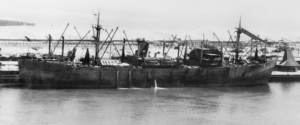
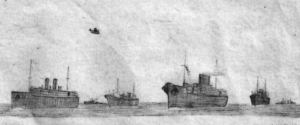
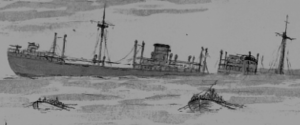
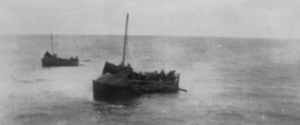
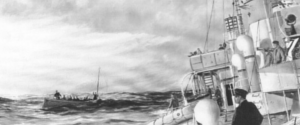
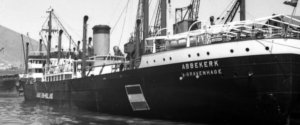




The planes were not Spitfires but Hurricanes
At this point not Singapore but Persia was the convoys destination. The locomotives on board were to be used on the railwayline engineers on one of the troopships were building to Russia.
Only when Pearl Harbour was attacked part of the convoy was rerouted to Singapore. In Durban they managed to unload some of the locomotives but some were still on board when she sailed for Singapore. Since the locomotives were build for a specific track-width, they had difficulties “getting rid” of that cargo later on.
Peter